If you’re looking for a versatile and nutritious vegetable to add to your home garden, spinach is the perfect choice. Not only does spinach provide a wide range of health benefits, but it is also a relatively easy plant to grow, making it an excellent option for both novice and experienced gardeners.
In this guide, I will share valuable tips and information on growing spinach plants, including the different types of spinach, care instructions, common diseases, and the nutritional value of spinach. I will also provide you with some delicious recipes and creative ways to incorporate spinach into your everyday cooking.
Key Takeaways:
- Spinach plants are rich in essential nutrients and can be grown in your own garden.
- There are different types of spinach, each with its own flavor and texture.
- Proper care and attention can help prevent common spinach plant diseases.
- Spinach is a versatile ingredient that can be used in a variety of recipes.
- Adding spinach to your diet can contribute to overall health and well-being.
The Science Behind Bolting Spinach
Bolting is a natural process in spinach where the plant transitions from its vegetative stage to its reproductive stage. This transition causes the leaves to develop a bitter taste. Bolting is an evolutionary adaptation that allows the plant to protect itself from being eaten while it is flowering and setting seeds. Factors such as daylight hours and temperature play a significant role in the bolting process of spinach.
Spinach plants go through different growth stages, starting from seed germination, followed by the development of seedlings, and then the vegetative stage where the leaves grow. Once the plant reaches a certain maturity, it undergoes a transition to the reproductive stage, also known as bolting. During this stage, the plant forms a flower stalk and produces flowers.
The timing of bolting can vary depending on various factors. One of the main factors is the length of daylight hours. Spinach is considered a long-day plant, which means it requires a specific minimum number of daylight hours to trigger the transition to the reproductive stage. Typically, spinach requires at least 14-16 hours of daylight to delay or prevent bolting.
Temperature is another crucial factor in spinach bolting. High temperatures, especially above 75°F (24°C), can accelerate the bolting process. Warm weather signals to the plant that it is time to reproduce, leading to the development of flower stalks and the bitter taste in the leaves. On the other hand, cooler temperatures can help delay bolting and prolong the spinach’s vegetative stage.
The bitter taste that develops in bolting spinach serves an evolutionary purpose. The bitterness acts as a deterrent to pests and herbivores, protecting the plant during the delicate process of flowering and seed production. By becoming less palatable, bolting spinach increases its chances of survival and successful reproduction.
To better understand the factors that influence bolting in spinach, researchers have identified several spinach bolting factors that regulate the transition to the reproductive stage. These factors include specific proteins and genes that respond to changes in light and temperature. By studying these factors, scientists hope to develop methods to control and manipulate the bolting process in spinach, allowing for extended leaf production and improved crop yields.
Factors Influencing Spinach Bolting
| Factors | Effect |
|---|---|
| Daylight Hours | Longer daylight hours can trigger bolting. |
| Temperature | Higher temperatures accelerate bolting, while cooler temperatures delay it. |
| Genetic Factors | Specific proteins and genes regulate the transition to the reproductive stage. |
Best Time to Grow Spinach
When it comes to growing spinach, timing is crucial. The best time to plant spinach depends on the climate and the desired harvest period. Let’s explore the two main options: spinach as a spring crop and spinach as a fall crop.
Spinach as a Spring Crop
For regions with long daylight hours, spinach is typically planted as a spring crop. As soon as the ground can be worked, usually in early spring, you can start planting spinach seeds or seedlings. This allows the spinach plants to take advantage of the longer days and warmer temperatures, resulting in robust growth and abundant harvest.
Here’s a quick overview of the steps to grow spinach as a spring crop:
- Prepare the soil by removing any weeds and adding compost or organic matter to improve fertility.
- Sow the spinach seeds directly into the garden, planting them at a depth of half an inch. Alternatively, you can transplant seedlings bought from a nursery.
- Space the spinach plants 4-6 inches apart to provide enough room for growth.
- Ensure the soil remains consistently moist, watering the plants regularly.
- Monitor for pests and diseases, applying organic measures to prevent and control them.
- Harvest the spinach leaves when they reach the desired size, typically around 40-50 days after planting.
Spinach as a spring crop offers fresh and tender leaves, perfect for salads, smoothies, and cooking.
Spinach as a Fall Crop
In cooler climates, growing spinach as a fall crop can be a great option. Planting spinach in mid-August allows the plants to mature during the shorter days and lower temperatures of fall. This timing helps to avoid the unfavorable bolting process, where the spinach plants transition to the reproductive stage, resulting in bitter-tasting leaves.
Here’s a summarized guide to growing spinach as a fall crop:
- Prepare the soil following the same steps as for a spring crop.
- Sow the spinach seeds directly into the garden, ensuring a depth of half an inch.
- Space the spinach plants 4-6 inches apart as well.
- Keep the soil consistently moist to support germination.
- Monitor the temperature and protect the plants from frost if necessary.
- Harvest the spinach leaves before they start to bolt, usually within 40-50 days.
As the weather cools down, you can enjoy the fresh taste of fall-grown spinach in your favorite recipes.
Remember: Spinach is a cool-season crop, thriving in temperatures between 50-70°F. Whether you choose to grow it as a spring or fall crop, providing the right conditions and proper care will ensure a successful harvest.
| Spring Crop | Fall Crop |
|---|---|
| Long daylight hours | Cooler temperatures |
| Planting as soon as the ground can be worked | Planting in mid-August |
| Harvesting in early summer | Harvesting in late fall |
Growing Spinach from Seed
Growing spinach from seed is a relatively simple process that allows you to have a bountiful harvest of nutritious greens. To ensure successful growth, it is crucial to use the correct sowing technique and get the timing right. Here’s a guide to help you get started:
Sowing Technique
When sowing spinach seeds, it is essential to prepare the soil properly. Start by clearing the area of any debris and weeds. Loosen the soil to a depth of 6 inches and remove any rocks or clumps. Adding organic matter, such as compost, can improve soil fertility and drainage.
Once the soil is prepared, create furrows approximately 1/2 inch deep and space them 12 inches apart. Place the spinach seeds in the furrows, keeping a distance of 1 inch between each seed. Lightly cover the seeds with soil and gently water the area.
Germination Time
Spinach seeds typically germinate within 5 to 10 days, given the right conditions. The ideal soil temperature for germination is between 50 and 70°F. Ensure the soil remains consistently moist during this period to support the germination process.
Seedling Care
Once the seedlings emerge, it is crucial to provide them with proper care. Thin out the seedlings to maintain a spacing of 4 to 6 inches between plants, allowing them enough room to grow. This will help prevent overcrowding and ensure adequate airflow.
Water the seedlings regularly, keeping the soil evenly moist. Avoid overwatering, as excessive moisture can lead to disease development. Applying a layer of mulch around the plants can help retain moisture and suppress weed growth.
Varieties of Spinach
There are several varieties of spinach available, each with its distinct flavor, texture, and resistance to bolting. Here are some popular varieties:
| Variety | Description |
|---|---|
| Savoy Spinach | A crinkled-leaved variety that is popular for its tender leaves and rich flavor. |
| Smooth-Leaf Spinach | A flat-leaved variety with a milder taste, perfect for salads. |
| Baby Spinach | Harvested at a young age, this variety has tender leaves and is great for salads and smoothies. |
| New Zealand Spinach | Not a true spinach, but a heat-tolerant alternative with thick leaves and a slightly tangy taste. |
Choose the variety that suits your taste and gardening conditions best to ensure a successful harvest of delicious spinach.
Planting and Care Instructions for Spinach Seeds
When it comes to growing spinach, there are two primary methods: direct sowing and indoor starting. Each method has its own advantages, and it’s important to choose the one that suits your gardening preferences and conditions.
Direct Sowing
If you prefer simplicity and want to save time, direct sowing is the way to go. It involves planting the spinach seeds directly into the garden soil, eliminating the need for transplanting.
To ensure successful direct sowing, follow these steps:
- Prepare the soil by removing any weeds and loosening it with a garden fork or tiller.
- Plant the spinach seeds half an inch deep in well-drained soil. Space the seeds 4-6 inches apart.
- Water the soil gently after planting to provide moisture for germination.
- Maintain a consistent soil temperature between 50-70°F. This range is ideal for spinach seed germination.
- Water the spinach plants regularly, keeping the soil evenly moist but not waterlogged.
- Apply a balanced fertilizer every 4-6 weeks to provide necessary nutrients for healthy growth.
- Monitor the spinach seedlings and thin them out when they reach a height of 2-3 inches. This process, known as thinning, ensures proper spacing between the plants.
Indoor Starting
If you want to get a head start on the growing season or live in an area with a shorter growing season, indoor starting is a great option. This method involves starting the spinach seeds indoors and transplanting the seedlings to the garden once they are established.
Here’s how you can successfully start spinach seeds indoors:
- Sow the spinach seeds in seed trays or small containers filled with seed starting mix. Plant them at a depth of half an inch.
- Place the trays or containers in a warm location with temperatures between 50-70°F. Ensure they receive adequate sunlight or use grow lights for proper seedling development.
- Keep the soil evenly moist throughout the germination period, which usually takes 5-10 days.
- Once the spinach seedlings have developed their first true leaves, they are ready for transplanting.
- When transplanting, space the seedlings 4-6 inches apart in well-prepared garden soil.
- Water the transplanted seedlings immediately and continue to provide regular watering as they establish in the garden.
- Apply a balanced fertilizer periodically to ensure optimal growth and development.
- Just like with direct sowing, thin the seedlings to maintain proper spacing and promote healthy growth.
Whether you choose to directly sow spinach seeds or start them indoors, it’s crucial to provide the right conditions and care for your plants. By following these planting and care instructions, you’ll be on your way to a bountiful harvest of fresh and delicious spinach.
Tips for Harvesting and Using Spinach Leaves
When it comes to harvesting spinach leaves, timing is key. You’ll want to wait until the plants have reached an appropriate size but before they start to bloom. This ensures that the leaves are tender and packed with flavor.
Once you’ve determined that your spinach plants are ready to be harvested, it’s time to get creative in the kitchen. Spinach leaves are incredibly versatile and can be used in a variety of delicious recipes.
One popular way to enjoy spinach leaves is in salads. Their vibrant green color and mild flavor make them a perfect addition to any salad. Try pairing them with fresh berries, nuts, and a tangy vinaigrette for a refreshing and nutritious meal.
Another option is to use spinach leaves on sandwiches. They add a crunchy texture and a burst of freshness to any sandwich. Combine them with your favorite ingredients like turkey, avocado, and tomato for a healthy and satisfying lunch option.
Of course, spinach leaves can also be cooked and incorporated into various dishes. You can sauté them with garlic and olive oil, add them to soups and stews, or even stuff them into omelets for a nutritious breakfast option.
It’s worth noting that spinach leaves are not only delicious but also incredibly nutritious. They are packed with vitamins A, C, and K, as well as iron, calcium, and fiber. Adding spinach to your diet can contribute to overall health and well-being.
So go ahead and start harvesting those spinach leaves and experiment with different ways to enjoy them. Whether it’s in salads, sandwiches, or cooked dishes, spinach is a versatile ingredient that can elevate any meal.
| Spinach Leaf Recipes | Description |
|---|---|
| Fresh Spinach Salad | A refreshing salad packed with spinach leaves, berries, nuts, and a tangy vinaigrette. |
| Spinach and Turkey Sandwich | A delicious sandwich with layers of spinach, turkey, avocado, and tomato. |
| Sautéed Spinach | Quickly sauté spinach leaves with garlic and olive oil for a flavorful side dish. |
| Spinach Omelet | Stuff spinach leaves into an omelet for a nutritious and protein-packed breakfast. |
Table: Spinach Leaf Recipes
Common Diseases of Spinach Plants
Spinach plants are not immune to diseases, and various issues can arise during their growth. It is essential to be aware of these common diseases to prevent them from affecting the overall health and productivity of your spinach plants.
Three common spinach plant diseases to watch out for are:
- Downy mildew: This fungal disease causes yellowish patches on the leaves, along with a white downy growth on the undersides. It thrives in cool, wet conditions and can lead to defoliation if left untreated.
- Leaf spot: Leaf spot is characterized by small, dark lesions on the leaves, which eventually expand and turn brown. It is caused by various fungal pathogens and can lead to severe leaf damage and reduced photosynthesis.
- Powdery mildew: Powdery mildew manifests as a white, powdery growth on the upper surface of the leaves. It is caused by fungal spores and tends to occur in warm, dry conditions. If left untreated, powdery mildew can stunt plant growth and reduce yield.
Preventing spinach plant diseases is key to maintaining plant health. Here are some effective prevention methods:
- Crop rotation: Avoid planting spinach in the same location each year to minimize the buildup of disease-causing pathogens in the soil.
- Maintain soil moisture: Ensure proper irrigation practices, providing enough water to keep the soil consistently moist but not overly saturated. Avoid prolonged foliar wetness.
- Timely removal: If you notice any diseased plants, promptly remove them from the garden to prevent the spread of diseases to healthy plants.
In some cases, despite preventive measures, diseases may still affect your spinach plants. When necessary, treatment with fungicides may be required. Consult with a local gardening expert or refer to the product labels for appropriate fungicide options and usage instructions.
Remember, staying vigilant and implementing preventive measures will go a long way in keeping your spinach plants disease-free and ensuring a bountiful harvest.
The Benefits of Growing Spinach Leaves
Growing spinach leaves in your own garden offers numerous benefits. Freshly harvested spinach is not only packed with nutrients but also provides a rich and satisfying taste.
Spinach is known for its high nutritional value. It is an excellent source of vitamins A, C, and K, as well as iron, calcium, and fiber. Incorporating fresh spinach into your diet can contribute to your overall health and well-being.
By growing spinach at home, you have the advantage of consuming the freshest leaves possible. This ensures that you get the maximum nutritional benefits from the spinach, as it retains its nutrients better when consumed soon after harvest.
Another benefit of growing spinach leaves is the cost-saving aspect. Store-bought spinach can be expensive, especially if you consume it regularly. By growing your own spinach, you can save money in the long run while enjoying the satisfaction of cultivating and harvesting your own food.
Spinach is also highly adaptable to cooler climates, making it an ideal vegetable for those living in regions with colder temperatures. It can withstand frost and even thrive in slightly cooler environments, allowing you to enjoy fresh spinach throughout the year.
“Growing your own spinach not only provides you with nutritious and fresh greens but also offers a cost-effective solution and the flexibility to grow it in cooler climates.”
Overall, growing spinach leaves in your own garden provides you with fresh, nutritious, and flavorful greens, while also saving you money and offering adaptability to cooler climates. It’s a win-win situation that allows you to reap the benefits of this versatile and healthy vegetable.
Conclusion
Growing spinach plants can be a rewarding and enjoyable experience. By following the tips and guidelines provided in this spinach plant guide, you can successfully grow your own spinach garden and enjoy the various benefits it offers. Whether you choose to grow spinach as a spring or fall crop, it is important to pay attention to the timing of planting, proper care, and potential diseases.
Start by selecting the right spinach seeds, considering their flavor, texture, and resistance to bolting. Remember that direct sowing is recommended rather than starting indoors to prevent premature bolting. Plant the seeds at the right depth and spacing, ensuring the soil temperature is within the optimal range for germination.
As your spinach plants grow, provide them with adequate watering, occasional fertilizer, and thinning seedlings to ensure proper growth and spacing. Harvest the spinach leaves when they have reached an appropriate size, and explore the various ways to use them in salads, sandwiches, and cooked dishes.
Lastly, keep an eye out for common spinach plant diseases such as downy mildew, leaf spot, and powdery mildew. Take preventive measures to minimize the risk of disease, such as crop rotation and maintaining soil moisture. In some cases, the use of fungicides may be necessary for treatment.
With the right knowledge and techniques, you can cultivate a lush and healthy spinach garden right in your backyard. So get started on your spinach cultivation journey and enjoy the fresh and nutritious rewards of growing spinach!


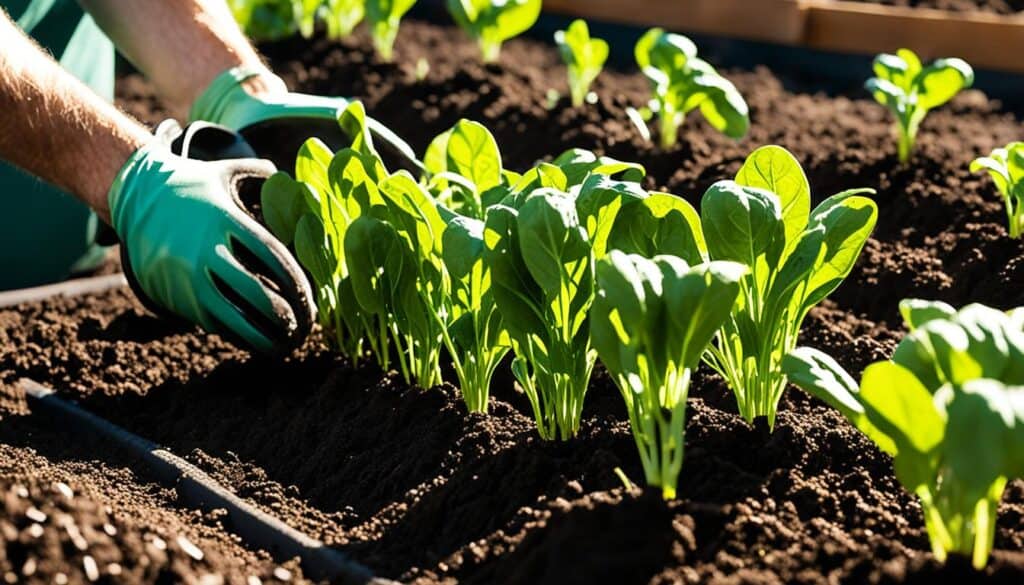
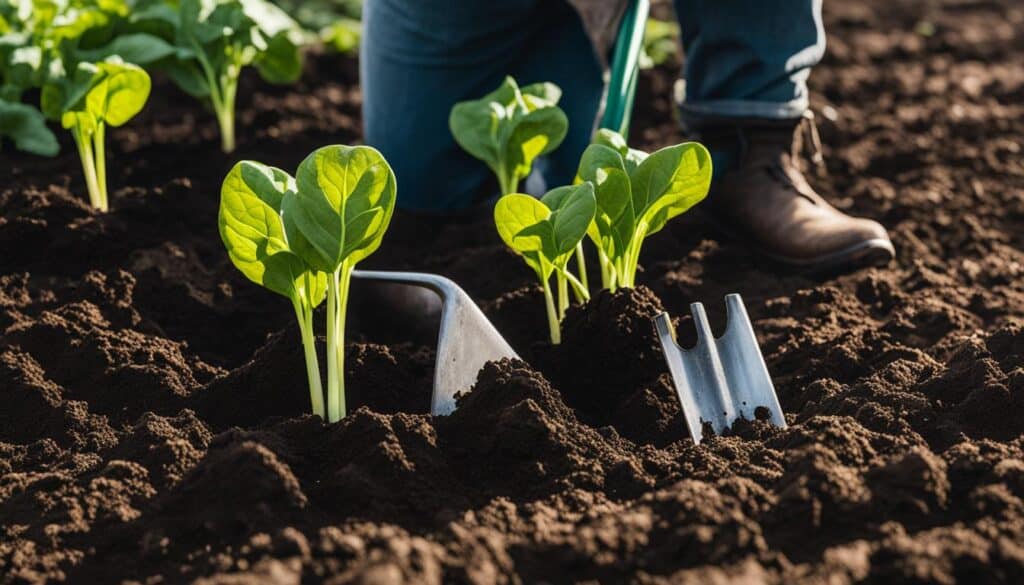
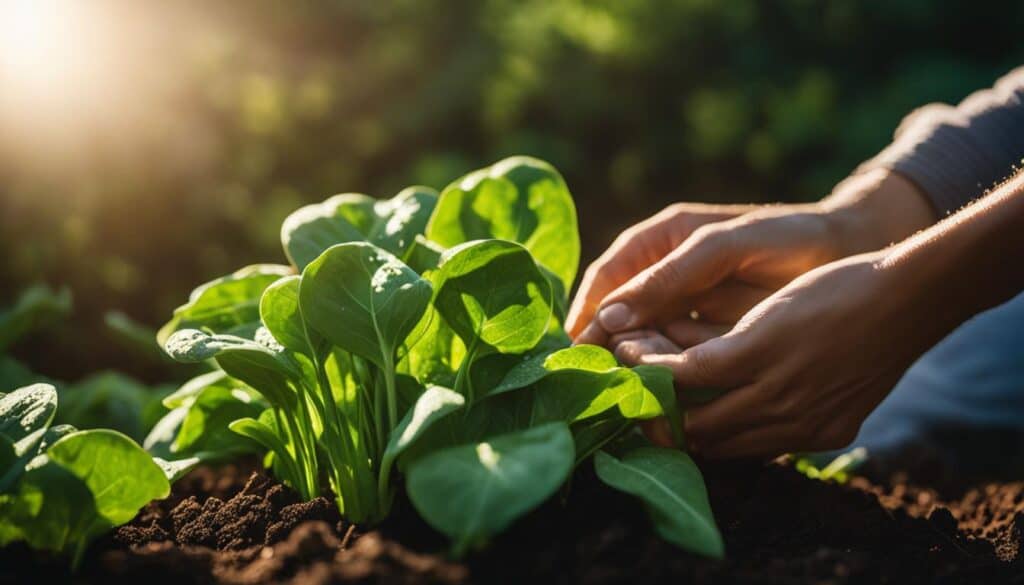
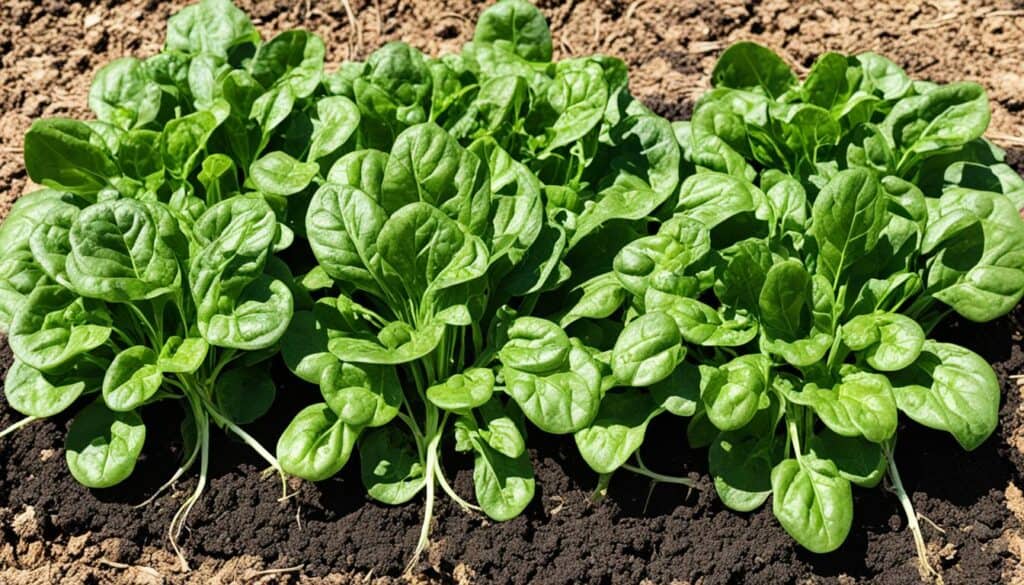
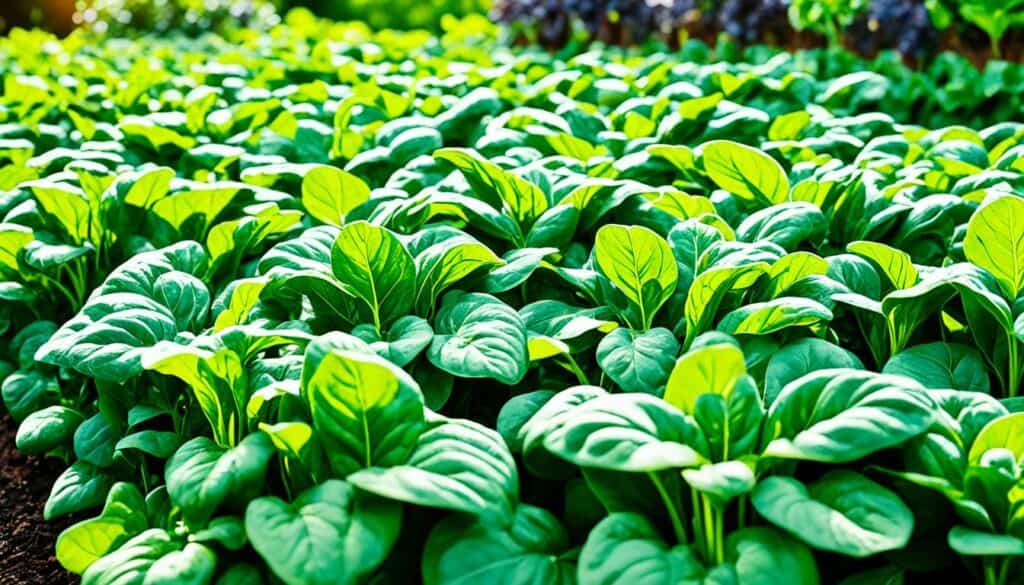



Leave a Reply